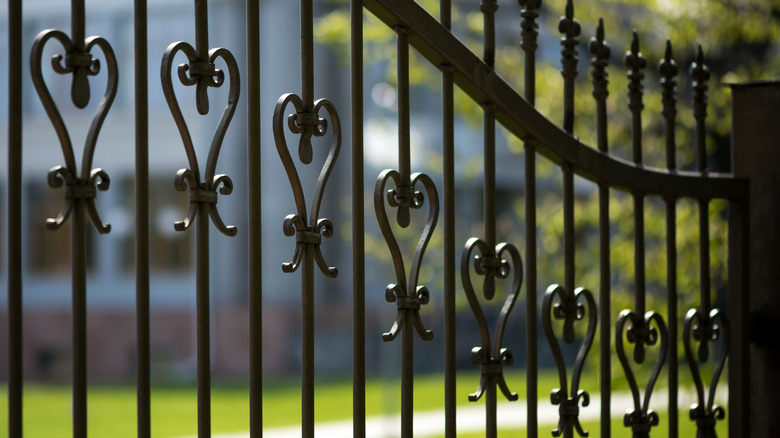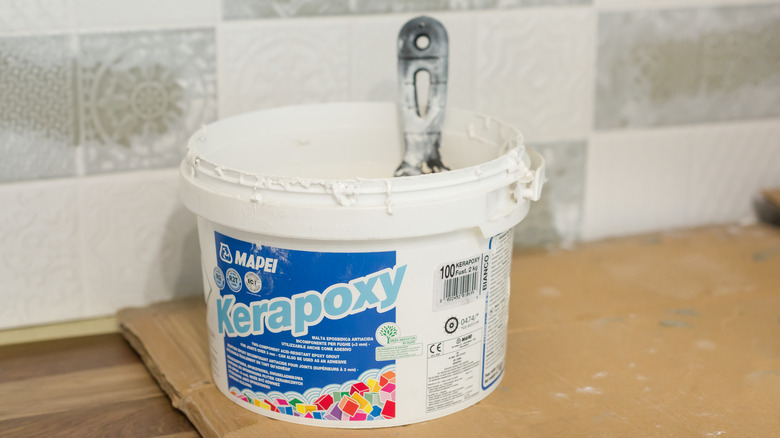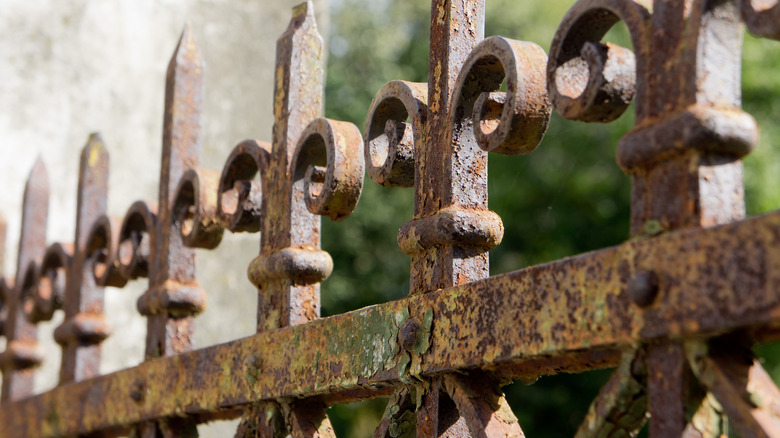How To Repair An Iron Fence
Whether ornamental or functional, an iron fence can add elegance and charm to a house's appearance. However, a fence in need of repair can have the opposite effect and turn it into something better suited to an "Addams Family" movie. While many fixes call for a pro or specialized skills, such as welding and metal stitching, basic fence repairs can be done by the homeowner using standard materials and relatively simple techniques. Iron fences are generally of two types: wrought and cast. Softer, porous, and malleable wrought iron is lighter than cast iron and is often forged on an anvil, according to Wagner Collaborative Metal Works. It is commonly used for fences and handrails. Aluminum is sometimes used as a substitute. Cast iron is derived from molten iron alloys poured into a mold and, though heavier, is less expensive than its wrought iron counterpart.
Professional fence repairs can be costly. The average price for fixing a wrought iron fence is more than $500, and up to $1,350 depending on the severity of the problem, according to Home Advisor. Fortunately, the usual suspects are rust or small breaks and cracks, and these can be remedied by even a novice DIY'er. Minor rust damage occurs frequently, but the good news is you can nip it in the bud before there are structural repercussions. A regular routine of inspecting and cleaning your fence is essential for maintenance, and will reveal any other defects that might need repairs.
Materials and techniques
Supplies necessary to repair a fence can be purchased at your local hardware store. According to Waterwelders, most fences with breaks can be mended with epoxy putty. Super glue can be used as an alternative adhesive. You'll also need work gloves, clamps, sandpaper, rags, and acetone or a comparable solvent. First, remove any rust from the area where bonding is needed, then carefully sand it and clean with solvent. Next use an old credit card or spatula to apply epoxy. Then secure the two pieces together with a clamp. Afterward, wipe away any excess epoxy.
Always observe safety rules when repairing metal. Glasses or goggles are a must to protect against metal shards or possible sparks. A face mask is recommended for filtering out iron dust particles. Use work gloves too. Make sure not to damage the fence you are working on. Top Line Fence suggests using painters tape to cover any areas you want to shield while you are making repairs elsewhere. A fence or gate with hinges can be treated with oil or grease to lubricate it and as a barrier against rust formation. A fence may have loose, broken, or rusted bolts. Tightening them may also require a lubricant. If bolts are missing, the U.S. National Park Service recommends removing one for comparison purposes. A fence's corner posts may have to be adjusted if the structure is not straight. Adding dirt under its base may also stabilize it.
Rust is the enemy
Rust is an iron fence's nemesis, and common causes include breaks or pits in the metal, chipped paint, humidity, and plants or dirt leaning against it. Neglected rust will invariably lead to corrosion and more extensive repairs. Stains, cracks, and bending may indicate that rust has progressed to corrosion. Neutralizing or removing rust is essential, and there are several rust-fighting materials and techniques to use when repainting later. Bear in mind, if there is one spot of rust, another is apt to be nearby.
La Habra Fence advises using a half-and-half mix of lemon juice and vinegar to attack rust and neutralize it. There are also rust "converters" which inhibit it from spreading. Per Top Line Fence, naval jelly containing phosphoric acid can be applied to rust with a paintbrush and later wiped off with mineral spirits. As a finishing touch, rust fillers can be used to plug up small holes. Once the rust has been treated, the repaired area (or even the entire fence) can be painted using rust-resistant primer and paint. The primer will seal the metal and resist moisture and corrosion. An oil-based spray enamel is also available to fight against rust. Prior to making repairs, the coat of rust and old paint can be removed by sandblasting.
Per the U.S. National Park Service, a rule of thumb when repairing a fence is to photograph it before undertaking any major repairs or renovations to make sure changes match.



